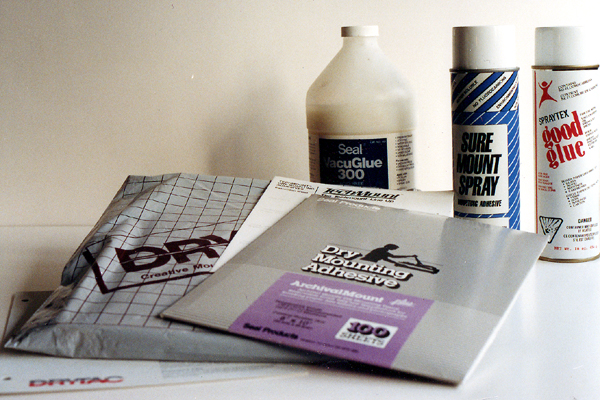
If thumbtacks are mounting...stainless steel thumbtacks must be conservation mounting! Only kidding. When considering the pros and cons of mounting within the realm of true conservation, wet, spray and dry mounting generally don't even seem to deserve a chapter for discussion. Confusing facts within the world of these particular forms of mounting include the adjective "acid-free" when referring to wet glues and pressure-sensitives and "archival" in relation to some dry mount tissues.

The fact is, that anytime an item is glued down to any substrate the conservation concept of a truly archival presentation has been violated, you may never truly bring that item back to it's original state. Archival treatment and handling of a piece of fine art refers to the relative permanence of materials used, their ability to remain stable over time and not altering the art's original state. Thus any procedure or material used in conservation framing must also be archival quality and more specifically (when mounting) no procedure should ever be done that is not reversible.
Removable does not mean reversible! The procedure of removing an item once mounted to a substrate, no matter how acid-free the adhesive may be, almost always leaves traces of adhesive residue behind. Even a minute amount of adhesive which may have soaked into the paper or fabric has altered that artwork from it's original state...thus veering from true archival guidelines.
There are many adhesive products which are categorized as acid-free, much to their credit. The active attempt in recent years to rid products of harmful acids and deteriorates has both benefited the framer and confused the issue. Generally speaking, most adhesives are considered inert, it's the tissue core or carrier that contains the acids. Rubber based adhesives as those used in masking and cellophane tapes and are actually considered neutral, yet are prone to yellowing. The question then is whether acid-free products will remain non-staining and non-damaging over the test of time.
Archival Dry Mounting
This brings me to the issue of product confusion. Often the names of tissues alone may evoke a false sense of security (ArchivalMount, Drychival, TechMount 4) for though they are removable, acid-free and may never actually harm the artwork, their very use restricts the art from ever being truly in it's natural unaltered state again, thus they are removable but not reversible. In fact there is adequate adhesive remaining so that once any print or photo has been removed from its tissue and substrate, you may readily remount it to a new substrate with no new tissue needed. It is also true that by using additional solvents (Unseal, Bestine Thinner) more of that adhesive residue may be removed, but color tests must be done to ensure the permanency of the inks and pigments of a print.
Tissue Use
When to use a tissue will depend upon each individual situation. General consensus favors hinging for items as limited editions, parchment, vellum, papyrus, bark paintings, fiber based photographs and watercolors, and lacing for needlework, stitchery, textiles and silks over adhesive mounting of any kind. There are those times however, when a client insists on mounting to ensure a smooth visual plane. So what do you do? If you elect to proceed with dry mounting, the smartest adhesive selection would be one that mounts quickly, at a low temperature (approximately 160-170ºF), remains removable and has an acid-free tissue core rather than 100% adhesive film (Flobond, Fusion 4000, TechMount 3).
Film adhesives may be prone to soaking into a thin material especially if left in the press too long at too high a temperature. Much like selecting the proper Japanese paper as a hinging material depending upon the weight of your artwork, selecting the proper adhesive with corresponding strength or delicacy when mounting to a substrate is vital. If a color tint is desired by mounting onto a colored substrate, then a film adhesive should be considered ("Ghosting Newsprint" PFM, November 1991).
Tissue Removal
Removable tissues and films are reactivated by resubmitting them to the heat of the press, slightly warmer for a little longer. When adequate time and temperature have been met to reliquify the adhesive, remove the project from the press and separate the artwork from the adhesive leaving the adhesive tissue still mounted to the substrate and the artwork free of the tissue. If archival tissues are placed in the press too hot, too long the adhesive excessively absorbs into the substrate and artwork making it extremely difficult to separate the remaining tissue from the back of the art (photo 2). So longer isn't necessarily better, and be prepared to discard the old substrate for a new one.
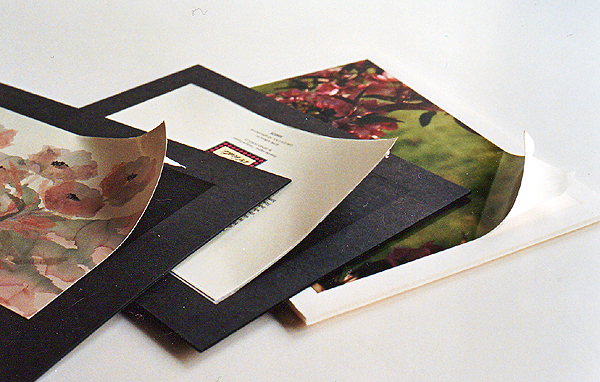 Photo 2
Photo 2
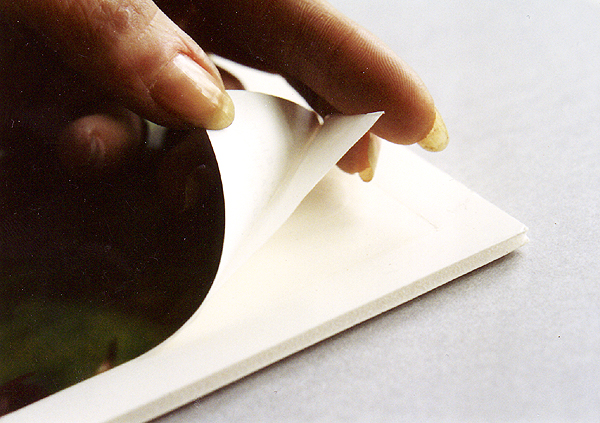 Photo 3
Photo 3
Slick paper stock and RC photos resist adhesive absorption so removal is quite easy (photo 3), but some toothy and rag paper stocks may cling aggressively to even a removable tissue (photo 4). Adhesives will travel towards the heat source so a possible precaution might be to reheat the project face down when preparing to remove a tissue in a press, the adhesive will then be more likely to pull into the disposable substrate than the print to be salvaged. As mentioned above, there will be adhesive residue remaining on the back of the artwork, and if liquid solvents are not a wise option you may continue to remount and remove the art until you are satisfied with the result. Additional adhesive will be removed each time as it will continue to be transferred into the new substrate. This removal procedure is the same for 100% pure film adhesives with no tissue core.
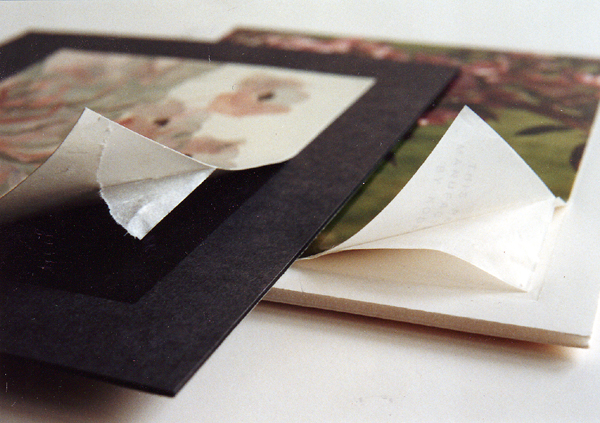 Photo 4
Photo 4
Wet and Spray Glues
As with dry mount tissues, many other adhesives for hand mounting and cold vacuum frames fall into similar removable and acid-free categories. Check manufacturer guidelines for mounting suggestions and pH levels, then let your conscience be your guide.
Permanent Tissues
The good news is that removal of permanent tissues may be achieved even when they are called "permanent". The bad news is you must use solvents in order to accomplish this maneuver and they generally aren't acid-free. UnSeal is an adhesive-releasing solution which is formulated to remove most artwork that has been mounted with most permanent dry mount, spray and pressure-sensitive adhesives. It may also be used to clean the press platen and to remove stains and fingerprints from photos.
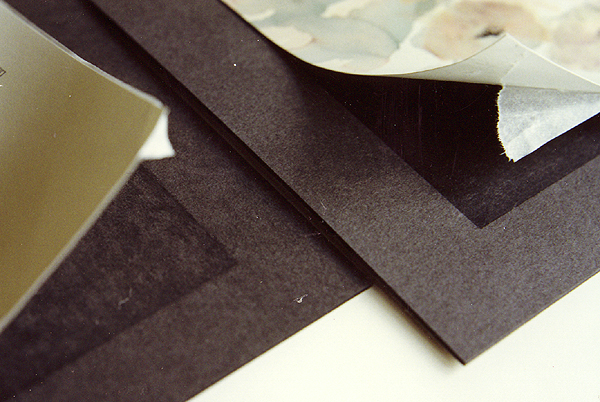 Photo 5
Photo 5
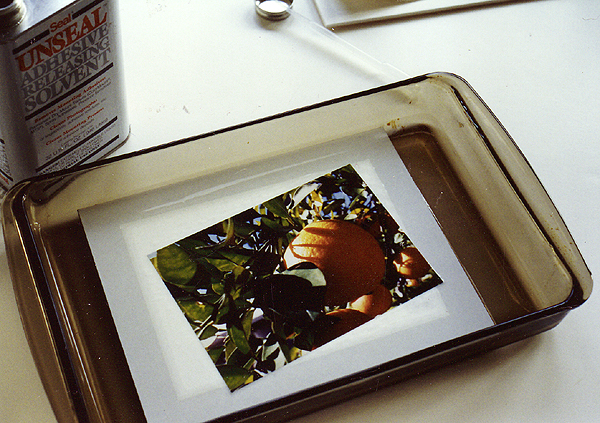 Photo 6
Photo 6
Prior to contacting any artwork with a solvent, tests must be done to ensure ink permanence.Saturate a Q-tip with the solvent and touch it to the various colors on a print as you would test a needlework for color permanence.Once verified, small images may readily be submerged into the solvent solution (photos 5 and 6) for about 5 minutes to dissolve the adhesive, then separate the image from the tissue and substrate unit (photo 7). The solvent evaporates rather quickly limiting the mess factor but you need to work fast (photo 8). It may also be saved for future use in another bath by pouring it back into the original container.Be sure to mark the contaminated can not to be used for cleaning the platen or photos.
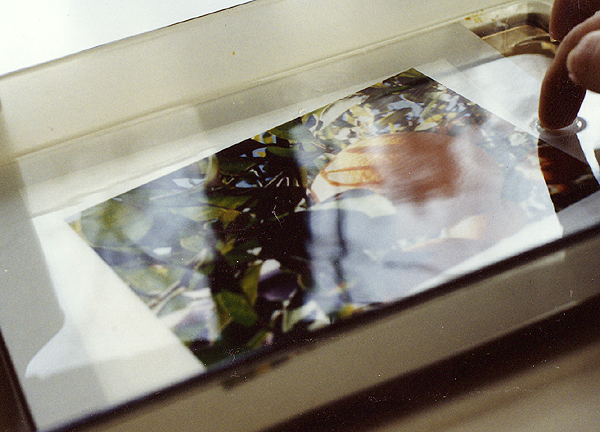 Photo 7
Photo 7
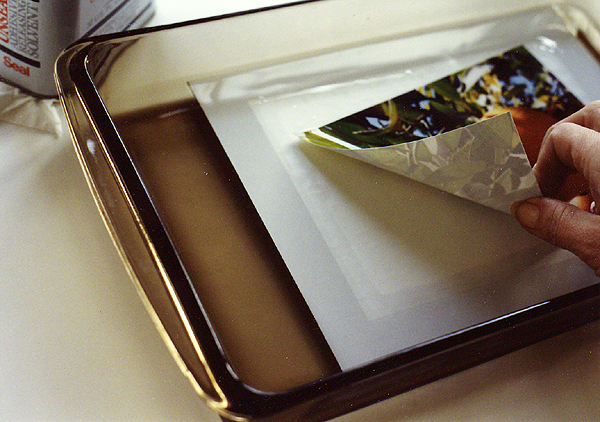 Photo 8
Photo 8
On a larger image, the process though achievable will be rather time consuming so you may wish to consider the options.Using an eye dropper, saturate the corner and begin to lift the image away from the tissue and substrate as it releases. Continue to flow additional solvent with the dropper under the lifted image as you separate it from the backing (photo 9, 10, 11, 12).
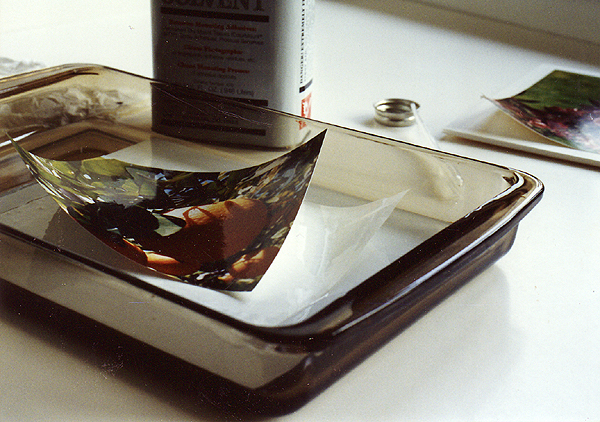 Photo 9
Photo 9
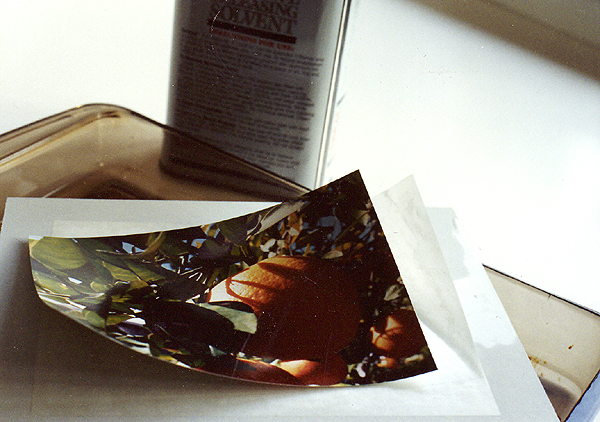 Photo 10
Photo 10
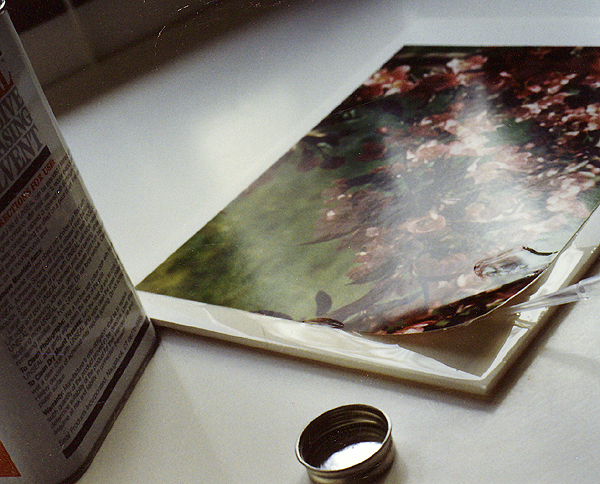 Photo 11
Photo 11
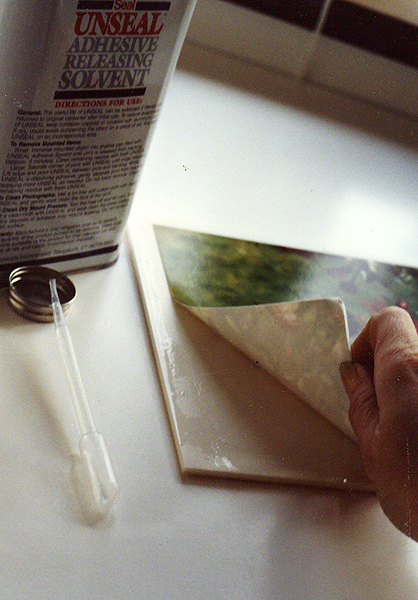 Photo 12
Photo 12
Recap
In recap, since dry mount tissues that are removable bond under weight as they cool, it stands to reason their removability will be achieved by reheating them. Permanent tissues bond in the press as they heat making them removable only through the use of solvents. Many wet and spray glues are water soluble (removable), non-staining and won't dry out though not necessarily acid-free.
So the moral of the story is to read your labels people, know the specifics and consider the options.If conservation archival methods of mounting are in order, pull out your Japanese hinges and think "reversible".If alternative methods of mounting are being considered, "removable" may be in order...otherwise there's nothing wrong with those good old "permanent" adhesives.
END
Copyright © 1993 Chris A Paschke
For more articles on mounting basics look under the mounting section in Articles by Subject.
Additional information on all types of mounting is found in:
The Mounting and Laminating Handbook, Second Edition, 2002,
The Mounting And Laminating Handbook, Third Edition, 2008 and
Creative Mounting, Wrapping, And Laminating, 2000 will teach you everything you need to know about getting the most from your dry mount equipment and materials as an innovative frame designer.
All books are available from Designs Ink Publishing through this website.
Chris A Paschke, CPF GCF
Designs Ink
Designs Ink Publishing
785 Tucker Road, Suite G-183
Tehachapi, CA 93561
P 661-821-2188
chris@designsinkart.com